
Welcome back...
Golly! Our fourth online newsletter - April deadline sneaked up on me. So much has happened with me this month and I finally got some precious quiet time to sit down on a plane and finished this newsletter. Almost 3,000 subscribers have signed up for our free monthly newsletter. WOW-- and thank you! And now the news. 

Loosening Up in New Mexico, Bob and Bev Taylor
The reception for my current "Wingland" exhibit in Farmington, New Mexico was wonderful. The gallery is part of San Juan College, where I also taught a 3-day "Loosen Up with Aquamedia Painting" workshop. Super fabulous people and well organized events. From New Mexico I hopped on a plane to Minnesota's North Star Watercolor Society to teach a 5-day Landscape Workshop. Once the plane touched down, it didn't take me long to begin "speaking Minnesota" - you betcha and doncha know! It's true what they say about the nice people of Minnesota.
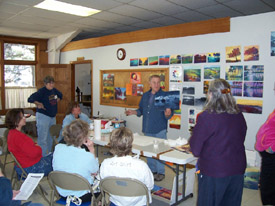
Landscape Workshop - Before Heading Outside


Martini Glasses - A Gift from Jane, the Grande Dame!
So - it's been a month of many things. Kind of reminds me about the time our three year old grandson Aiden, after his first visit to a 747 cockpit and seeing 100s of buttons and switches -- "Look Popo, lots of many things!" 
Product Spotlight

The New Goof-Proof Color Wheel
As a painter, believe it or not, I have been classically trained in art college. I have used the universally accepted color wheel for many years. It works well. After fifteen years of using this color wheel however, one day and for way-too-much-fun, I changed my color wheel to five primary colors instead of the standard three primaries... just to see what would happen. After many goofing around times in my studio, I came up with what I call the Burridge Goof-Proof Color Wheel. For the past three years I have experimented and created a new "Wingland" body of work using this new method of color combination. It is not scientific, but it is based on color theory - and me just playing around with unconventional color combos. I am blown away with the results. When I started introducing my Color Wheel in different workshops, I had many requests to reproduce it for sale. In my last two workshops in Farmington, New Mexico and Minneapolis, Minnesota, I sold out of the Color Wheels!
"If you are looking for a new WOW in your next paintings, try the New Burridge Goof-Proof Color Wheel. It works great! So will your new paintings. Includes Goof-Proof Color Wheel, Step-by-Step Instructions, Plus Color Combination Examples"

For info on ordering go to:
www.robertburridge.com/Products

Workshops in the Spotlight
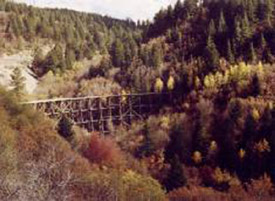
Tressle at Cloudcroft
• We're going to Cloudcroft, New Mexico this July! "Escape to the Lincoln National Forest during the heat of the summer for an artistic experience you won't soon forget. A week or two nestled in the cool, peaceful mountain forests of Southern New Mexico will spark your creativity and artistic talent."
We are very honored to be going to this very special place. The Village of Cloudcroft is nestled in the Sacramento Mountains of Central New Mexico at 9,000 feet above sea level. This alpine setting provides a cool refuge from the summer heat in the rest of the country. You might think we're crazy going to New Mexico in July, but they tell me that their summer temperatures average a lovely 70-75 degrees. And the Cloudcroft organizers promise breathtaking views from the village and nearby hiking trails in the Lincoln National Forest of White Sands National Monument and the San Andres Mountains one hundred miles away.
The Cloudcroft Art Workshops were named #1 Art Workshops in the July, 2006 issue of New Mexico Magazine! See article: zianet.com/cloudcroftart/Article1.htm
"Loosen Up with Aquamedia Painting" July 9-13, 2007. Go to their website and check it out! www.cloudcroftart.com
More information regarding the Village, area attractions and lodging may be found at the Cloudcroft Chamber of Commerce website: www.cloudcroft.net
• Join us in Guatemala this November for a painting workshop and cultural tour! Brochures are ready now! Contact Kate at rburridge@robertburridge.com to have a brochure sent to you or contact John Korte for more information regarding registration and costs at www.exploreguatemala.com

Views of Guatemala
Recommended Book
"The Yellow House - Van Gogh, Gauguin and Nine Turbulent Weeks in Arles" by Martin Gaylord (ISBN 978-0316769013) published by Little, Brown and Co, 2006. It is practically a daily account during the nine weeks the "odd couple" lived and painted together in Arles, France - ending with Van Gogh's death. I was intrigued and enlightened to discover the details of how the two painters worked, what inspired them, their visits to museums, how they were treated by the locals and their constant communication with their art dealer in Paris, Theo.
You might envy their experiences and feel their anxiety, realizing you're not that different from them or other painters who go to their studios and make paintings! The Yellow House is a good read-- some photos, black and white. My companion piece to this book is "Van Gogh and Gauguin - The Studio of the South" - by Douglas Druick and Peter Kort Zegers. Many color pictures, showing the work produced during those nine wild weeks. Published by Thames and Hudson, Inc. in conjunction with the exhibition "Van Gogh and Gauguin - The Studio of the South" 2002. ISBN# 0-500-51054-7. 
Art Marketing Tip
Get Involved - Exposure Equals Success!
To keep your art and your name in the hearts and minds of local customers, consider getting involved in a community project. Bob has participated in San Luis Obispo's Mozart Festival for eight years. They have had many different types of fundraisers, including poster sales and silent art auctions. The past two years have been very exciting and fun for the local artists because the Mozart Festival jumped on the bandwagon of painted musical instruments, like many other communities have done. Last year twelve artists were asked to paint on actual violins for a live auction fundraiser. This year, instead of restricting it to violins exclusively, the other instruments in the orchestra were added! Bob received a French Horn to paint.

Bob Paints Violin for Mozart Fundraiser


This Year's Mozart Donation - "Tutti Frutti"
We like doing these local fundraisers. It gives us the opportunity to meet and interact with a new audience - and also reminds the local community that he is still an active force. It also makes for good publicity and gives Bob a chance to "giveback" to projects that he believes in.
If you want to get involved with a community fundraiser, be prepared to do the following:
1. Create a piece of artwork that is your best work! Never donate a piece you are not proud of or create a so-so piece of artwork for a fundraiser. You want to increase the caliber of your reputation and your marketability for the organization. Make sure you can complete and deliver your artwork by the deadline.
2. This is just like doing an exhibition. Be ready with an updated bio and artist's statement, photos of your work, etc. Create a one-page stand-alone sheet for the artists' binder (showing qualifications of the artists involved in the project). Be ready with information for publicity.
3. If there is an event, like an auction or a dinner, show up! When the artist is there, it automatically increases the visibility and potential for good publicity and sales. Besides, it's great marketing on your part - don't forget your business cards!
4. Get the name of the purchaser from the organization. This is your newest collector and your "new best friend!" Write them a thank you note. Enclose a brochure, invite them to your studio, etc.
5. Write thank you notes to the organization. Ask for extra brochures, invitations, copies of publicity and photos for your files.
6. Add this experience to your resume. Put it on your website.
You can do this! Besides, it's great fun! 
Introducing... Ask Kate!
The ArtsyFartsy News is starting a new segment - ASK KATE! Every month, Kate will post your questions and her responses on the subject of marketing, sales, and promotion. So if you have a burning question that you would like to have answered -- for your benefit and everyone else's -- email Kate at kate@robertburridge.com 
|
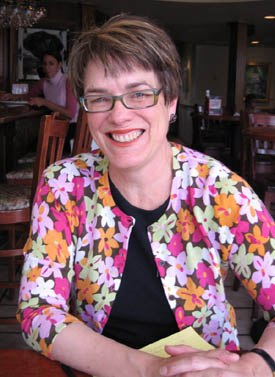
"Kate - Your Art Marketing Girl!"
Click HERE for top of page.
|
|
 |

The Composition of the Month
This month... Asymmetrical. Also known as "off-balanced." This is so classic! You've seen it mostly in landscape paintings where there are a lot of trees all to one side and then some small tree or isolated element far away. Most likely it's also the focal point.

Asymmetrical Start
In designing the composition, my first few strokes on the canvas are bold, graphic brush marks. I build the painting from there. As I said in last month's newsletter, I can remain loose and free in my painting and paint all over with confidence as long as I remain in integrity with the design composition. It's a morning warm-up in my studio -- I paint six small, loose paint sketches, utilizing an asymmetrical shape as the initial bold stroke. I play from there.
Next month I will feature the third of twelve design compositions. 

Abstract Asymmetrical Composition


Landscape Asymmetrical Composition
Something New for Bob
Making Mud and How to Get out of It
You know what I mean. We all do it so well! In fact, we continue to make muddy colors from beautiful, clean, bright paint and we don't think too much about how not to continue doing it. (Unless of course, we want to create those dull, brownish, sticky paintings!) But for all those painters who want to avoid mud, here's some helpful hints...
First - The paint that comes out of the tube is the brightest and cleanest it will ever be. However, the more we handle it, squishing it around, the duller the paint becomes. The trick therefore, is to paint by barely touching it. Put it on the canvas, but then get off the canvas. As the French Impressionists discovered - short, choppy strokes. Get in, get out. The paintings stay bright. We make "mud" by handling the paint too much. In fact, we swirl it around, over blend it and continue to mix and scrub the paint, hoping that the color will get better! In fact, we painters have such a hopeful attitude that we believe the more we swirl the paint, even more good will happen. Actually, what happens is the paint becomes a pile of brown you-know-what! But, again our positive attitude kicks in and we tell ourselves, "With all these piles of poop, there's got to be a pony in here somewhere!"
Second way of making mud - Mix together complementary colors. Churn it up and you get mud! But this can be turned into a good thing by mixing in lots of Titanium White. The mud becomes a subtle, dove gray color. It's a gorgeous neutral.
Here's a cool suggestion: After making the neutral gray color, lay on top of it the original two clean complementary colors and notice how brilliant and light the colors become. Now you know how to make mud and how to turn the muddy disaster into a successful creation. Try it - it's cool! 

Mixing Complements = Mud
Mixing Titanium White into Mud = Neutral Tone


Example of Using Complementary Colors & not Making Mud
The Magic Studio
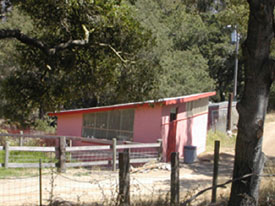
The Beloved "Haybarn" Studio for ten years.
In the past, I have said so many times that I am one of the fortunate artists out there who goes and paints in my studio everyday. Hard to believe for eighteen years I have painted almost everyday in some sort of a studio space. I recall throughout those times I've painted in a variety of "studio" spaces... a closet, a garage corner, a porch, under an oak tree (rain or shine), a laundry room and for ten years, my beloved studio space was a 20 x 20 foot haybarn in the middle of our farm field. The point here is I had a place to go to do my work. I have learned that to do significant work, you go to a work place --- away from daily distractions like phones, refrigerators, television, noisy (and nosey) neighbors, i.e. interruptions!
While I travel the world teaching workshops, I have been hearing so many painters who bemoan the fact that they can't paint until they get their studio in perfect condition: the right easel, color balanced lights or that special brush to paint tree branches or wicker basket weave... really!
This is all nonsense of course. If you truly are a painter, one who needs to create (not duplicate), you'll go to your place and make stuff. Nothing can stop you from painting and doing what you just have to do. A studio space is an essential ingredient for doing good work. Wherever you paint, call that place "your studio." Say it out loud... "My studio." It's affirming and also sends a clear message to others that you are an artist and this is what you do. You paint.
If you paint in your garage, call that place your studio. ("I park my car in my studio.") If you paint in that extra bedroom, call it your studio and make it your studio by removing all bedroom furniture --- and cover or remove that rug! One artist I know in this situation, covered the rug with sheets of plywood. Good idea.
If you paint in a kitchen corner or enclosed porch, call it your studio. And when company visits, do not clean, straighten up or remove your studio stuff. This is where you do your work. It's not supposed to be a stage set where you only "act" like a painter. Besides, and believe me, as a painter, you are a curiosity to your friends. They really want to see where you do what you do--- "open studios" are very popular right now for this reason! And your friends feel extra special because they have a friend who is an artist. So enjoy your life as an artist. Heck, flaunt it!
Never apologize for your imperfect studio. For me, my perfect studio was, indeed, not perfect. My roof leaked, the windows had no glass, bird nests in the ceiling rafters, farm animals wandered thru and the cement floor slanted. Perfect! It was here I could splash paint everywhere, scribble on the walls, pour paint on huge canvases and make lots of experimental messes. There was no fear of ruining a thing. I loved the energy, the freedom and a place to go! And finally, more to the point--- even when you don't feel inspired to paint, go to your studio anyway. Like a "real job," you show up--- even if all you do is sit there and look at your work, read your art books or write in your journal.
Having said all that, I'm almost uneasy in announcing this next part. I recently moved into a brand new studio - ultra new. Yikkes! The story goes like this: A few months ago, before a pending rain storm, I crawled up on the studio roof to cover it with plastic sheeting. The studio (rotting sheep shed) roof could not support my weight and I went through. The solution was a new roof - so I thought! But I was convinced the entire building would soon blow down. It had lived a long, serviceable life and it was time to be replaced. Within a day, it was torn down and in its place a larger studio was built over the top of the existing foundation, keeping the previous ten years' of good cosmic energy intact. We saved the paint-splattered studio walls for the memories. After eighteen years I finally have a place that has northern light, electricity, a level floor, water, a library, a writing desk, canvas storage and... a real roof.
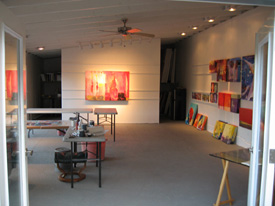
Walking into the Magic Studio
I'm shocked to suddenly find myself walking around and not just reaching for... It's huge inside, 24 x 48 foot. It started with a dream. Seeing my studio finished and walking into it, I got the clear message that painting is the center of my life. It had the atmosphere of absolute conviction. Thank you patrons and clients. You bought me a new studio. 

Bob's New Studio. It Started with a Dream.
It's No Secret!
Oh, get over yourself! This is for artists and art instructors who hesitate explaining how they do something because it's a "secret." Secret?? First, let me tell you - there are no secrets. Not only has it all been done before, it's all been documented and published in one form or another.
Revealing secrets or not revealing secrets can be a source of great stress for artists-- Oh, get over yourself! The fear here of course is that if you reveal how you do something, someone will rip you off, or you will no longer be unique. Personally, I don't have a problem revealing how I do something. My own passion and reason for painting comes from not how I paint, but rather why I paint. "Why I paint" is not a thing. I can't give it to you. The "why" is my personal motivator, my vision and my goal for the next painting. I feel there has to be a reason why you feel compelled, or have the overwhelming desire to paint. Accumulating "how-to" knowledge is valuable, but it's only a small part of the big picture.
So, emerging artists, get over yourself and end this silly notion that you can not do your next best work until you have all the answers or know the "secrets."
Only you can ask yourself why you paint. Only you can ask yourself - What is your vision?

Happy Bob Working on his Next Vision
Think about this...
Vision without action is day dreaming.
Action without vision is a nightmare!
Vision with action is a painting worth
doing. 
How to Live Your Dream
Everyone should be so lucky to live their dream!
• Invest some time in yourself.
• Surround yourself with supportive people.
• Lean over the edge a little.
• Test out your dream.
• Talk to others.
• Be passionate about it.
• Take the high road - you'll look and feel better.
• Stick with it - even though you don't want to.
• Be out of touch so you can get away.
• Cut away all the extraneous stuff that does not serve you.
Do not allow others to influence you if they do not have your same dreams! No person has the right to instill or insert their "baggage" on your dreams. I continue to be aware of others who attempt to discourage me from doing things that they can't imagine doing themselves!
Keep your brushes wet! 

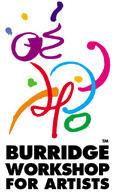

Copyright ©2007 Robert Burridge. All rights reserved.
If you wish to copy this material to other publications or mail lists, please ask for permission by contacting:
Robert Burridge Studio
Arroyo Grande, California
805-459-1503
rburridge@robertburridge.com
www.robertburridge.com
|
|
 Burridge Home
|
ArtsyFartsy News
|
ArtsyFartsy News Sign Up
Burridge Home
|
ArtsyFartsy News
|
ArtsyFartsy News Sign Up
 Burridge Home
|
ArtsyFartsy News
|
ArtsyFartsy News Sign Up
Burridge Home
|
ArtsyFartsy News
|
ArtsyFartsy News Sign Up